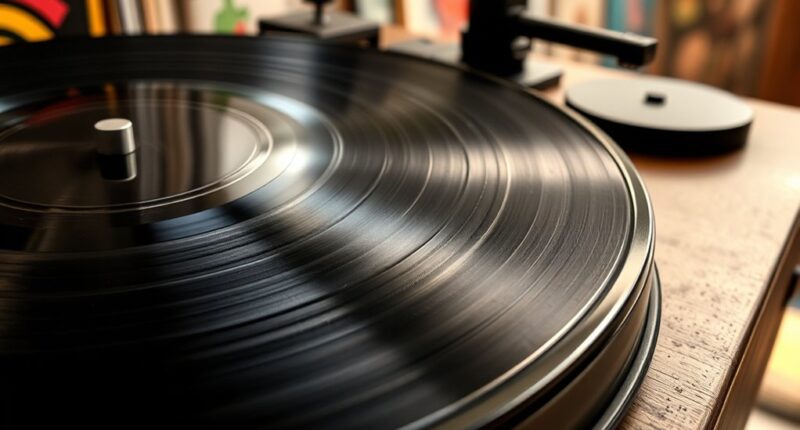Pressed-on-demand vinyl makes it easier to get albums quickly and customized, but it also challenges traditional collectibility. Since these records are often produced in larger quantities, their rarity and limited-edition appeal decrease, which can harm their long-term value. While they broaden access and popularity, serious collectors worry about authenticity and quality. If you’re curious how this trend impacts the collector’s market, there’s more to contemplate ahead.
Key Takeaways
- On-demand vinyl lacks traditional scarcity, reducing its desirability for serious collectors.
- Variability in quality and authenticity concerns can diminish the perceived value of on-demand records.
- Reproducibility and mass production lower the rarity that drives long-term collectible worth.
- Limited editions and unique packaging are essential for preserving value, which on-demand often bypasses.
- Overall market perception views on-demand vinyl as less authentic, potentially harming its long-term collectible appeal.
The Rise of Pressed‑On‑Demand Vinyl: A New Era for Music Fans
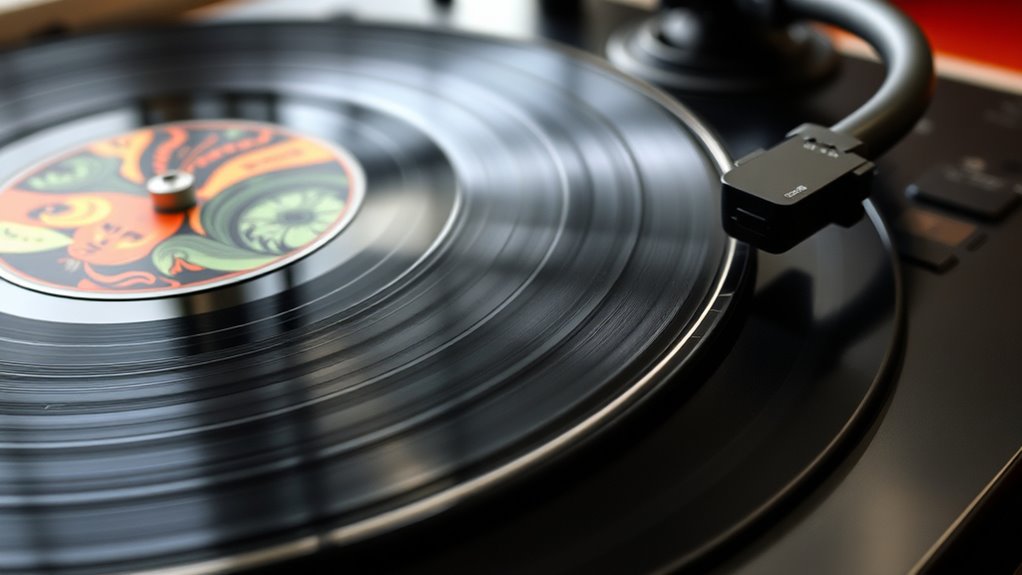
As digital music dominates, pressed-on-demand vinyl has emerged as a game-changer for collectors and fans alike. This technology allows you to order records directly from manufacturers, often with minimal delay, making rare or out-of-stock albums accessible again. It’s revolutionized how you experience music, offering a personalized touch that digital formats can’t match. No longer do you need to hunt for limited editions or pay inflated prices; you can simply request a copy whenever you want. This shift has democratized vinyl collecting, giving more people the chance to build their collections easily. Additionally, advances in pressing technology have improved the quality and durability of these records, ensuring they meet traditional standards of sound fidelity. The second trimester of the vinyl resurgence isn’t slowing down but evolving into a more flexible, customer-centric model that puts you at the center of the experience. Moreover, the rise of custom pressing options has allowed for even greater personalization, further enhancing the appeal of on-demand vinyl.
Understanding the Production Process of On‑Demand Vinyl Records
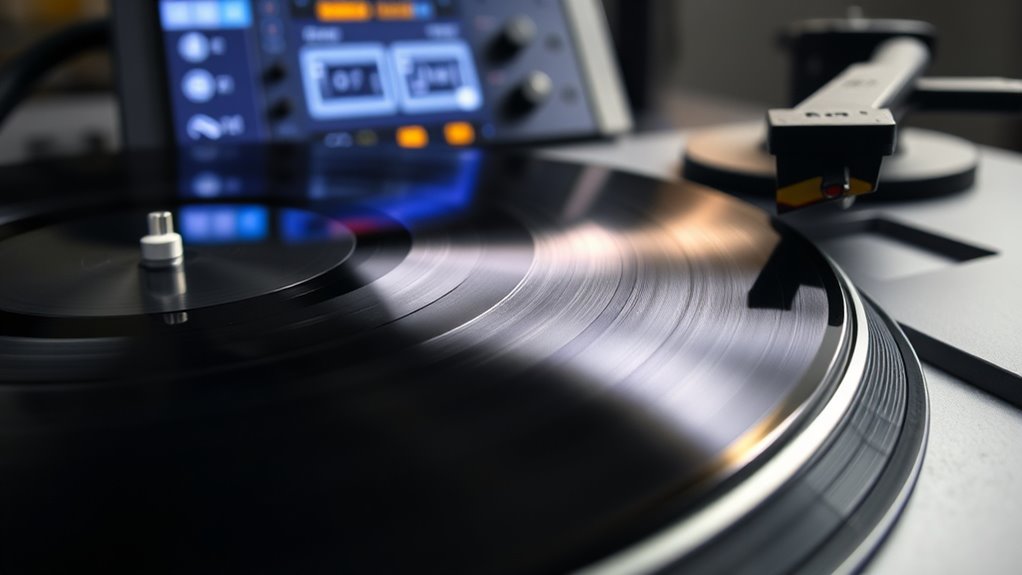
Understanding how on-demand vinyl records are produced begins with digital file preparation. You start by ensuring your audio files are high-quality and properly formatted, typically in WAV or FLAC formats. Once finalized, the files are uploaded to the on-demand pressing company’s system, where they’re converted into a master for vinyl production. Unlike traditional pressing, the process doesn’t involve creating large stampers or molds upfront. Instead, a digital-to-analog conversion occurs, generating a unique stamper for each order. This digital approach allows for quick, flexible manufacturing, often with minimal setup time. The digital master then guides the laser etching or engraving process on a vinyl blank, producing a ready-to-ship record. This streamlined process enables on-demand production without the need for extensive physical molds or large runs. digital-to-analog conversion is a key step that distinguishes this process from traditional methods. Additionally, the digital nature of this process can impact the collectible value of the records over time.
Comparing Traditional Vinyl Pressing and On‑Demand Techniques
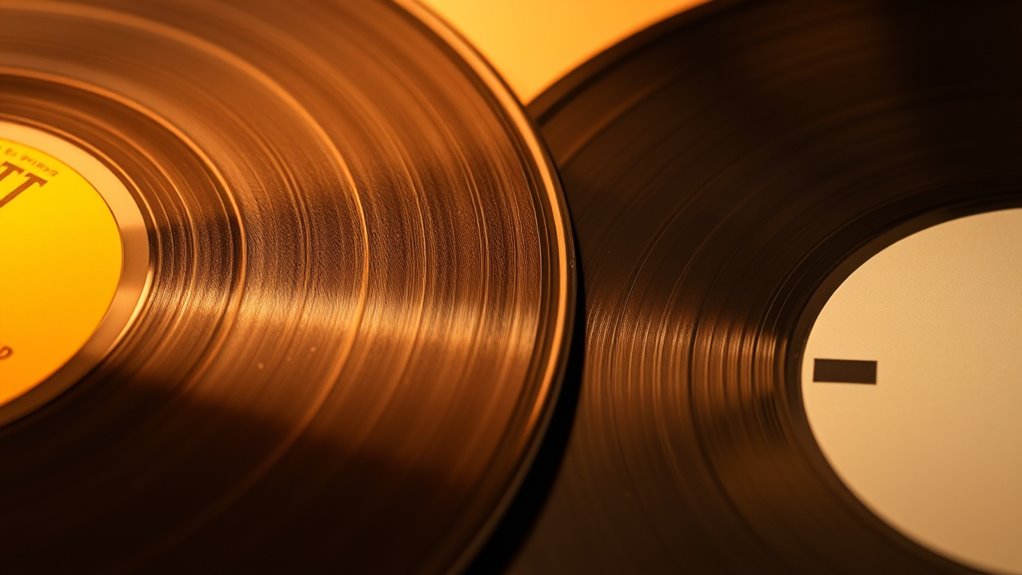
When comparing traditional vinyl pressing to on-demand techniques, you’ll notice differences in authenticity and sound quality that matter to collectors. On-demand methods often produce less scarcity, affecting their collectibility and value. Understanding these points helps you decide which approach best suits your needs and preferences. Incorporating mindfulness practices like focused attention can also help collectors appreciate the nuances of different pressing methods and make more informed decisions. Additionally, the production process used in on-demand pressing can influence the overall sound fidelity and perceived value of the record. Moreover, the aesthetic appeal of pressed-on-demand vinyl may differ from traditionally pressed records, potentially impacting their desirability among collectors.
Authenticity and Sound Quality
Traditional vinyl pressing is often regarded as the gold standard for authenticity and sound quality because it involves meticulous craftsmanship and extensive quality control. You’ll notice that records pressed this way often have richer, warmer tones and a fuller dynamic range. In contrast, pressed-on-demand vinyl may sometimes lack the depth and nuance, due to quicker production processes. To illustrate, consider this comparison:
| Aspect | Traditional Pressing | On-Demand Pressing |
|---|---|---|
| Sound Quality | Richer, more dynamic, warmer tones | Slightly compressed, less depth |
| Authenticity | Handcrafted, historically proven | Digital files, rapid production |
| Craftsmanship | Detailed QC, artisanal techniques | Automated, faster process |
| Collectible Value | Generally higher, perceived as authentic | Often lower due to quick turnaround |
Your listening experience can vary markedly based on these differences. Additionally, enthusiasts often value traditional pressing because it preserves authenticity and the integrity of the original master recordings. Moreover, the craftsmanship involved in traditional methods often results in a more durable and higher-quality product, further enhancing its collectible appeal.
Scarcity and Collectibility
While sound quality often influences a record collector’s choices, scarcity and collectibility also play essential roles in determining a vinyl’s value. Traditional pressing methods produce limited runs, creating natural rarity that drives up desirability and worth. These records often become sought-after collectibles, especially if they’re limited editions or have historical significance. In contrast, pressed-on-demand vinyl is produced in larger quantities, making it easier to access but less rare. This abundance can diminish their value among collectors seeking exclusivity. If you’re looking to invest or build a valuable collection, scarcity is key. While on‑demand records may appeal for convenience, they typically lack the rarity that boosts long-term collectibility and resale value. Your approach should consider whether rarity or accessibility matters most to your collecting goals.
The Impact on Rarity and Limited Editions in Vinyl Collecting
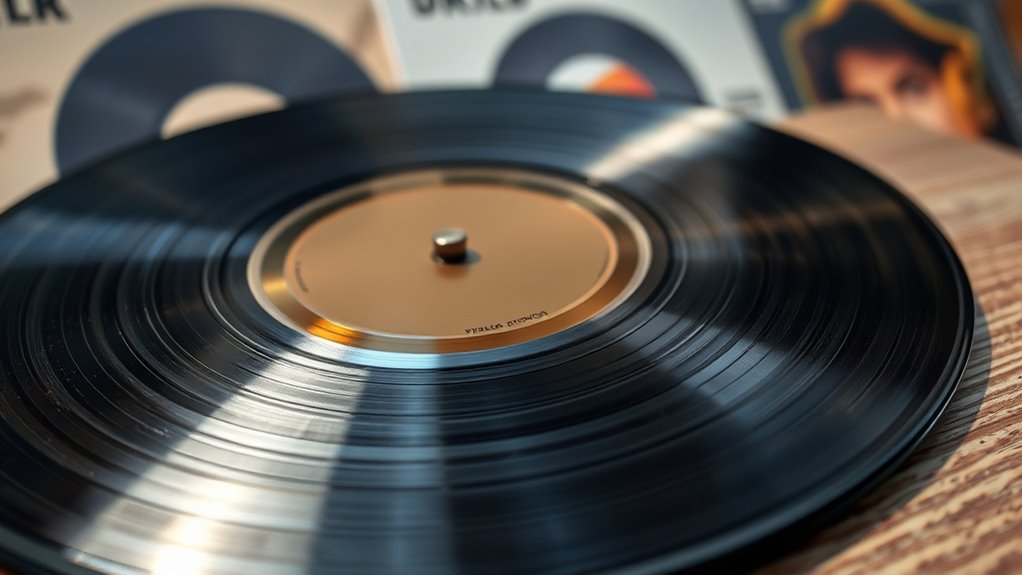
Pressed-on-demand vinyl has considerably altered the landscape of rarity and limited editions in vinyl collecting. Because these records can be produced quickly and in small batches, traditional scarcity no longer guarantees exclusivity. Limited editions no longer hold the same value when copies can be replenished or repressed on demand. This shift means collectors might find it harder to distinguish truly rare records from more common releases. The excitement of hunting for rare editions diminishes when the availability is flexible. As a result, the perception of rarity shifts from physical scarcity to factors like packaging, artwork, or pressing details. Ultimately, on-demand production challenges long-standing notions of rarity, making it harder for collectors to rely solely on limited edition status to determine a record’s value.
Authenticity and Quality Concerns With On‑Demand Vinyl
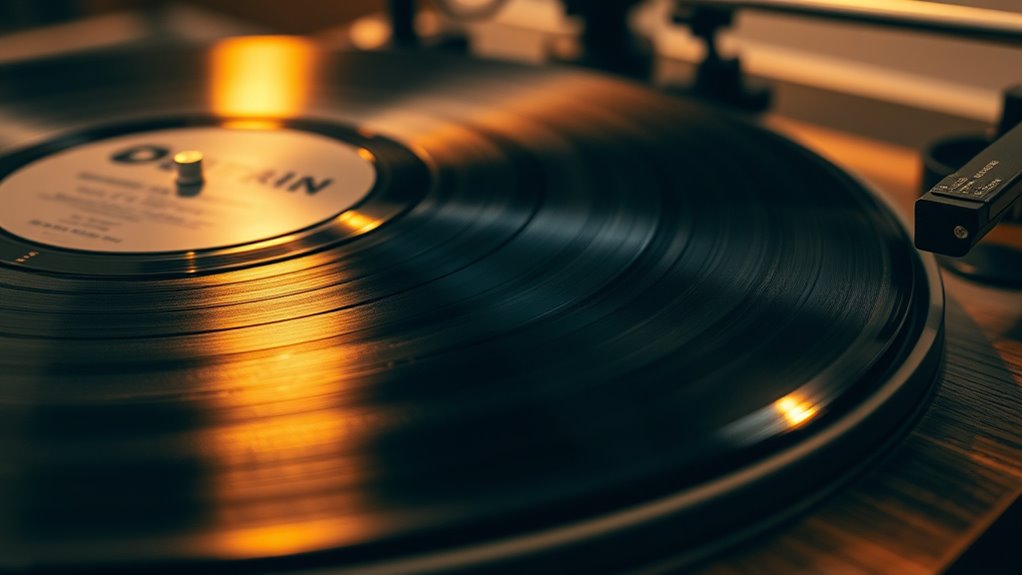
You might wonder how to verify the authenticity of pressed-on-demand vinyl, as quality can vary between producers. Sound quality isn’t always consistent, which can impact your listening experience. Plus, limited collectible value may make these records less appealing for serious collectors.
Authenticity Verification Challenges
Authenticity verification for on-demand vinyl presents significant challenges because the rapid production process makes it easier for counterfeit or low-quality copies to enter the market. With less oversight and fewer quality checks, distinguishing genuine pressings from fakes becomes difficult. You might encounter fake labels, misprinted covers, or unauthorized copies that look convincing. To protect yourself, watch out for:
- Inconsistent serial numbers or missing holograms
- Poor print quality or mismatched artwork
- Lack of official licensing or barcode information
- Suspiciously low prices compared to retail
These signs can help you spot counterfeit or questionable releases. Since on-demand vinyl is produced quickly, verifying authenticity relies heavily on careful inspection and trusted sources. Vetted – Grobal World emphasizes that materials and production methods can vary, which impacts authenticity. Without proper verification, you risk purchasing a fake that could devalue your collection. Additionally, understanding the dog names associated with collectibles can help identify genuine items that match specific branding or licensing cues. Moreover, authenticity cues such as consistent packaging standards are crucial in differentiating legitimate releases from counterfeit ones.
Sound Quality Variability
Because of the quick turnaround in production, sound quality on on-demand vinyl can vary widely, often resulting in inconsistent listening experiences. Since these records are pressed rapidly, the quality of the audio depends heavily on the production process and equipment used. You might notice differences in clarity, bass response, or overall fidelity from one pressing to another. Sometimes, you’ll encounter surface noise, pops, or skips that wouldn’t typically appear on traditionally pressed records. This variability can affect your enjoyment, especially if you’re an audiophile or collector seeking high-quality sound. Additionally, on-demand presses may not undergo the same rigorous quality control as mass-produced vinyl, increasing the likelihood of defects. This lack of consistent quality assurance can lead to discrepancies that diminish the collectible value of these records. Furthermore, the pressing process itself often involves fewer steps, which can contribute to these inconsistencies in sound quality. Limited production standards and equipment calibration can also play a significant role in the quality variations observed. Moreover, the rapid manufacturing process may sometimes compromise the durability of the records, affecting their long-term value.
Limited Collectible Value
While on-demand vinyl offers quick and affordable access to new releases, it often falls short when it comes to establishing genuine collectible value. The authenticity of these records is questionable, as they lack the limited pressings and historical significance that make traditional collectibles desirable. You might own a copy, but it won’t carry the same prestige as vintage or limited-edition vinyl. Concerns include:
- Reproducibility: Easily duplicated, reducing rarity.
- Material quality: Often uses cheaper materials that degrade faster.
- Lack of provenance: No clear history or limited-run info.
- Market perception: Buyers view them as less valuable or disposable.
These factors make on-demand vinyl less appealing for serious collectors, risking devaluation over time.
How Collectors View Pressed‑On‑Demand Records in the Market
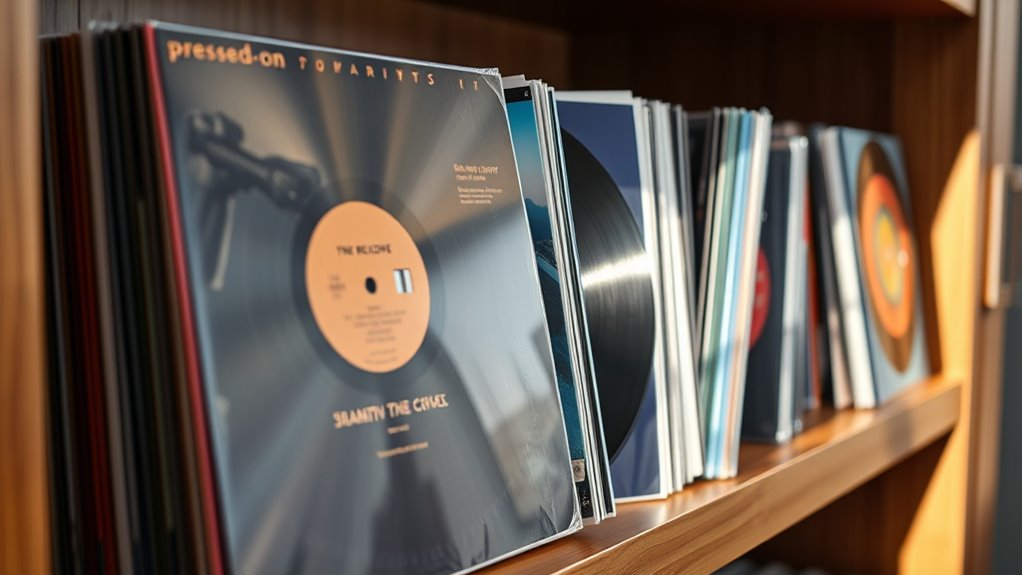
Collectors tend to have mixed feelings about pressed-on-demand vinyl. Some see it as a convenient way to access favorite albums without hunting for rare editions. They appreciate the affordability and the ability to fill gaps in their collections quickly. However, many view these records skeptically, questioning their authenticity and long-term value. They worry that pressed-on-demand vinyl lacks the uniqueness and craftsmanship of traditional pressings, which can diminish its desirability. Some collectors also see it as a threat to the integrity of the market, fearing it encourages mass production and devalues rare, vintage records. Overall, while pressed-on-demand vinyl offers immediate access, it often doesn’t carry the same prestige or collector’s value, making opinions divided about its role in the market. Additionally, the perception of quality and the manufacturing process involved can influence how collectors value these records over time.
The Future of Vinyl Collectibles Amid Growing On‑Demand Trends
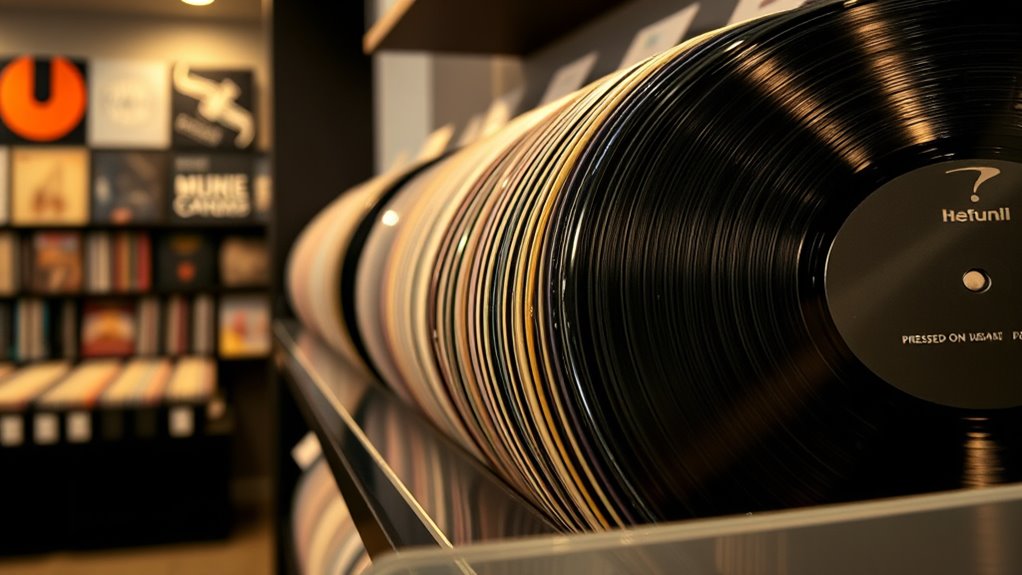
As on-demand vinyl production continues to grow, the landscape of vinyl collectibles is set to transform considerably. You might see more personalized and limited-edition releases, making it easier to access rare or custom records. This shift could lead to increased competition among collectors, driving prices up for certain items. However, it may also dilute the sense of exclusivity that once defined valuable collectibles. Be aware that mass-produced on-demand records might challenge traditional valuation methods, making it harder to determine genuine rarity. To stay ahead, you’ll need to:
On-demand vinyl growth challenges rarity and valuation, urging collectors to focus on limited editions and historical significance.
- Focus on authentic limited editions
- Track production runs carefully
- Prioritize historically significant releases
- Recognize the impact of digital reproduction on value
This evolving environment encourages strategic collecting, blending passion with savvy.
Strategies for Preserving Value in the Age of Instant Vinyl Production
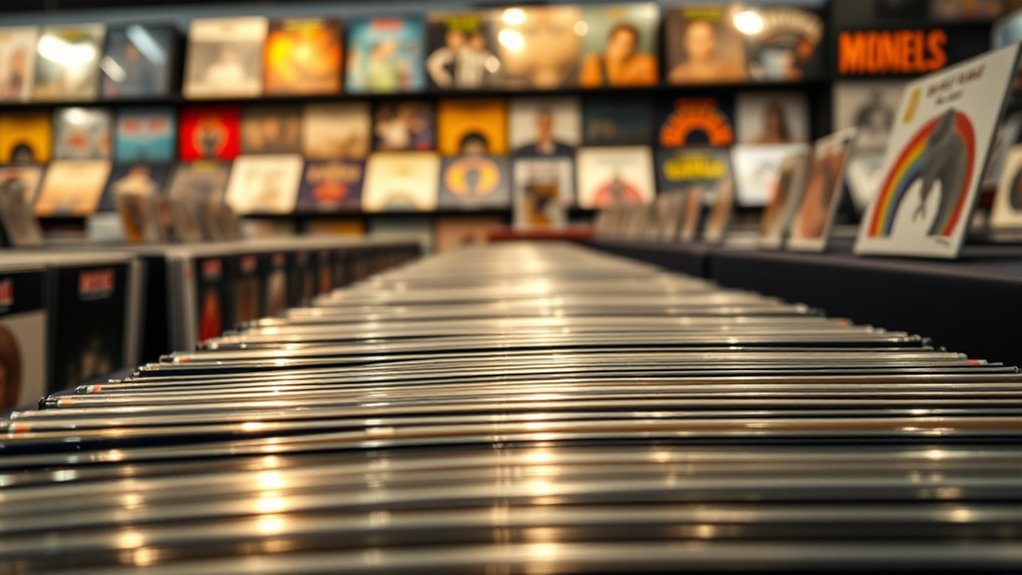
With the rise of on-demand vinyl production making it easier to create personalized and limited-edition records, protecting your collection’s value requires strategic action. First, focus on acquiring rare or historically significant records, as these tend to retain or increase in value despite widespread production. Avoid mass-produced or promotional releases that flood the market and dilute worth. Properly store your records in a cool, dry environment, and handle them carefully to prevent damage. Keep detailed records of your collection, including purchase history and condition. Consider grading and appraising your most valuable items. Lastly, stay informed about market trends and avoid impulsive purchases of trendy or limited-edition releases that quickly saturate. These steps help safeguard your collection’s long-term value amid growing instant vinyl options.
Balancing Accessibility and Exclusivity in Vinyl Collecting
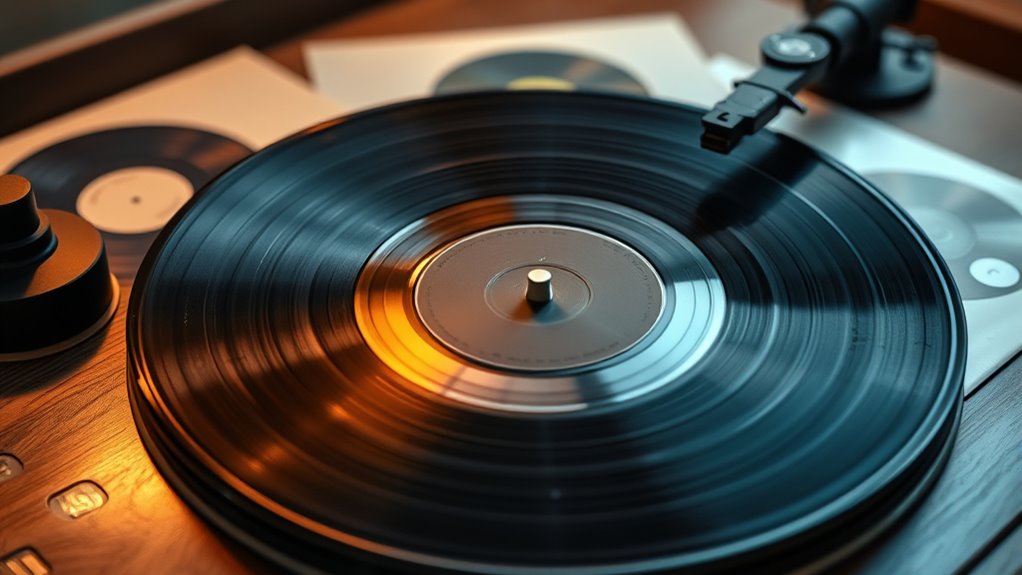
Balancing accessibility and exclusivity in vinyl collecting requires a strategic approach that caters to both casual listeners and dedicated enthusiasts. You want to make rare finds available without flooding the market, maintaining their desirability. To do this, consider:
- Limiting pressings to preserve rarity
- Offering exclusive editions for loyal fans
- Using tiered pricing to differentiate release types
- Creating online platforms for trusted resale
This approach ensures that collectors feel special while newcomers can enjoy discovering new music. It’s about striking a balance that keeps the market vibrant but not oversaturated. By carefully managing production and distribution, you maintain the integrity and value of collectible vinyl, fostering a healthy collector community that appreciates both accessibility and exclusivity.
Frequently Asked Questions
How Do Pressed-On-Demand Vinyl Records Affect Resale Values?
You might wonder how on-demand vinyl impacts resale value. These records are often produced in limited runs or custom orders, which can make them seem more unique. However, because they aren’t mass-produced and lack the rarity of original pressings, their resale value tends to be lower. Collectors usually prioritize original, rare releases, so pressed-on-demand vinyl generally doesn’t appreciate the same way traditional records do.
Are There Differences in Sound Quality Between Traditional and On-Demand Vinyl?
You might notice that traditional vinyl often offers richer sound quality with better warmth and depth, thanks to analog mastering processes. On-demand vinyl, however, can sometimes sound less dynamic or slightly compressed due to digital conversions and pressing methods. While some listeners may not notice a big difference, audiophiles tend to prefer traditional records for their superior audio fidelity. So, your choice impacts the listening experience profoundly.
Can Pressed-On-Demand Vinyl Be Considered Truly Collectible?
You might wonder if pressed-on-demand vinyl can be truly collectible. While it offers quick access, many collectors see it as less valuable because it’s mass-produced and lacks the rarity of limited editions. You probably realize that true collectibles often depend on scarcity and uniqueness. So, pressed-on-demand vinyl may not hold the same value over time, but it’s still great for enjoying music without the wait.
Do Artists or Labels See On-Demand Vinyl as a Threat or Opportunity?
You might wonder if on-demand vinyl is seen as a threat or opportunity. Artists and labels often view it as a chance to reach fans quickly and customize releases, boosting sales and engagement. While some worry it could flood the market and reduce rarity, many see it as an innovative way to stay relevant. Overall, they tend to see it as an opportunity to adapt and grow in a changing industry.
How Does Pressing on Demand Impact the Overall Vinyl Market Stability?
You might think on-demand vinyl helps stabilize the market, but it can actually shake things up. By allowing quick, affordable pressings, it encourages more releases, which may flood the market and reduce the value of limited editions. While it offers consumers fresh choices, it risks turning collectibles into common items, making it harder for true rarities to hold their worth. It’s a double-edged sword, and balance is key.
Conclusion
Just like Pandora opening her box, pressed-on-demand vinyl offers instant access but risks releasing chaos into the collector’s world. While it makes music more accessible, it can diminish the thrill of rarity and exclusivity. To preserve your treasures, treat these records like the mythical elixir—valuable not just for sound but for the story and effort behind them. Balance innovation with tradition, and your collection will remain a legend in its own right.
